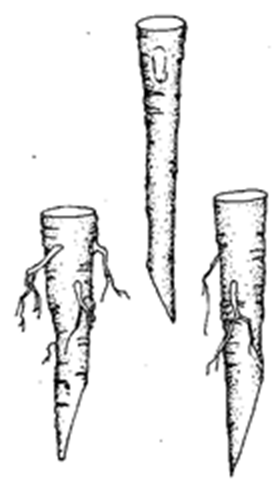See Chick pea
Garden pea,
See Pea
Gourd,
See Squash, winter
Green bean,
See Bean, green or snap
Green,
See Beet, Chard, Collard, Kale, Turnip
Honeydew melon,
See Muskmelon
Horseradish
Common name: horseradish Botanical name: Armoracia
rusticana Origin: Eastern Europe
Varieties
New Bohemian.
Description
Horseradish looks like a giant, two-foot radish. In fact, it’s a hardy perennial member of the cabbage family. Ninety-eight percent of all commercial horseradish is grown in three Illinois counties near St. Louis. Horseradish has a very strong flavor and — like the animal for which it’s named — can deliver a powerful kick when you’re not expecting it.
Where and when to grow
Horseradish is a very cold-hardy plant, which does well in the North and in cool, high-altitude areas in the South. Grow it from crowns or roots planted four to six weeks before the average date of last frost for your area.
How to plant
Horseradish tolerates partial shade and needs rich, well-drained soil. Turn over the soil to a depth of 10 to 12 inches, and remove stones and lumps that might cause the roots to split. When you’re preparing the soil, dig in a complete, well-balanced fertilizer at the rate of one pound per 100 square feet or 10 pounds per 1,000 square feet.

Horseradish
Plant the roots in a trench, and place them 24 inches apart with the narrow end down. Fill in the trench until the thicker end is just covered.
Fertilizing and watering
Fertilize before planting and again at midseason, at the same rate as the rest of the garden. Detailed information on fertilizing is given in “Spadework: The Essential Soil” in Parti.
Keep the soil evenly moist so that the roots will be tender and full of flavor; horseradish gets woody in dry soils.
Pests
Horseradish has no serious pest problems.
Diseases
Horseradish has no serious disease problems.
When and how to harvest
Plants grown from roots cannot be harvested until the second year. A 10-foot row should give you six to eight roots. Horseradish makes its best growth in late summer and fall, so delay harvesting until October or later. Dig the roots as needed, or in areas where the ground freezes hard, dig them in the fall. Leave a little of the root in the ground so that you’ll have horseradish the following year, too.
Storing and preserving
Store in a glass jar in the refrigerator one to two weeks. To freeze, grate the roots and mix with vinegar and water, as specified in “How to Freeze

Plant horseradish roots narrow end down.
Vegetables.” You can also dry horseradish or store the roots in a cold, moist place for 10 to 12 months. Detailed information on storing and preserving is given in Part 3.
Serving suggestions
Horseradish is a classic accompaniment to beef roasts and steaks. Serve it solo, freshly grated, to brave souls who appreciate its full flavor. For the less stern of stomach, calm the flavor with whipped or sour cream. Serve it as one of the dipping sauces with a beef fondue. Since the fumes are very strong, grate horseradish outdoors if you can. If you must do it indoors, use a blender.
